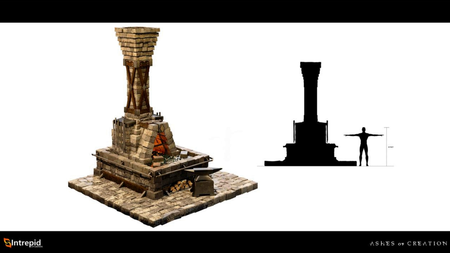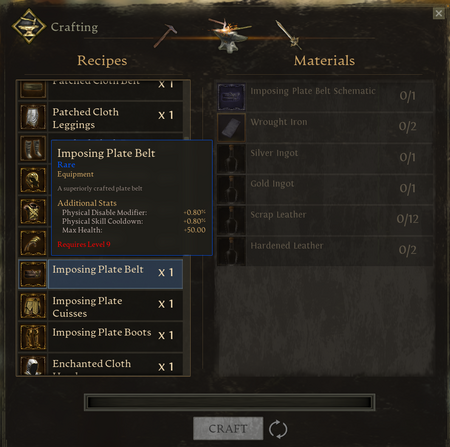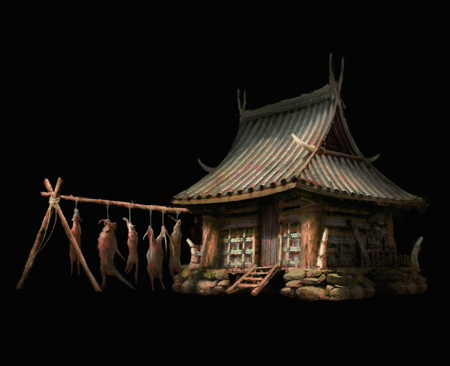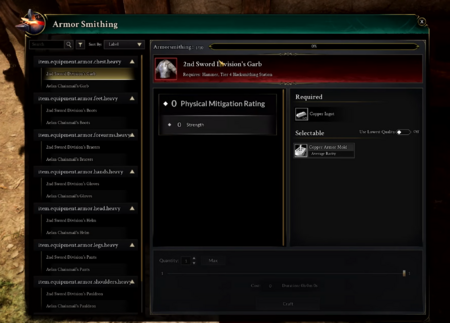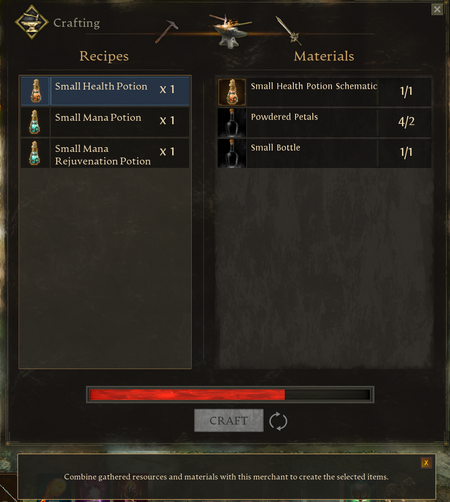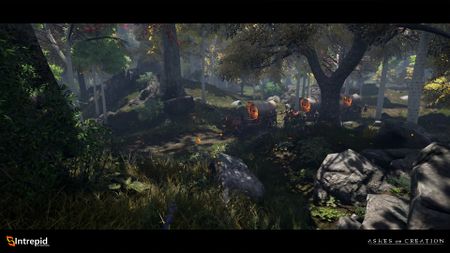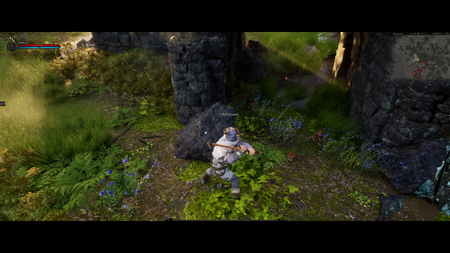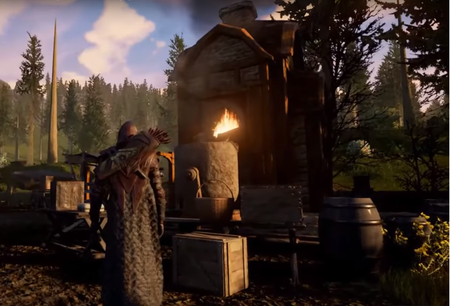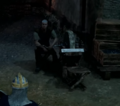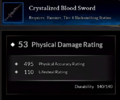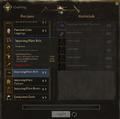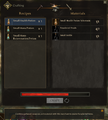Ремесло
Производство это один из ремесленных классов в Ashes of Creation. Оно является движущей силой в игровой экономике.[2]
Все, что вы захотите создать в игровом мире, будет создано игроками: неважно, корабли это, осадные машины, оружие, броня или что-то еще.[3] – Джеффри Бард
Ремесленные профессии
- Arcane Engineering
- Armor smithing
- Carpentry
- Jewel cutting
- Leatherworking
- Scribing
- Tailoring
- Weapon smithing
Crafting mechanics
Игроки могут выбрать специализацию производства .[4]
- Будут разные уровни ремесленных производственных станков, которые отражают качество создаваемых предметов.[5]
Производственные станки могут быть расположены во владениях или на узлах.[5][6]
- В: Можно ли мобилизовать/перемещать производственные станки и размещать их в любой точке мира? ?
- О: Это зависит от производительных станков . Будут разные уровни ремесленных станков, которые представляют вам известное качество предмета, который вы хотите создать в рамках этой конкретной профессии. Будут производительные станки, которые игроки смогут использовать в своих владениях, а так же производительные станки, предназначенные только для развития определенных узлов, в определенных областях или конкретных зданиях... сделать его более динамичным и что-то вроде того, что предостерегает игроков от того, как они решают построить мир, и какова ценность этих вещей. [5] – Steven Sharif
Повторяющиеся механики крафта, основанные на навыках, такие как мини-игры, не являются запланированной частью крафта.[7][8]
Мы обсуждали тот тип функции, когда мастерство ремесленника давало бы больше вариантов крафтов. Таким образом, чем выше ваш уровень мастерства в создании определенного предмета, тем больше может быть ваш потенциал повлиять на качество этого предмета... Очевидно, что при разработке системы такого типа мы беспокоимся о том, что мы не хотим что такое развлечение - вы знаете из-за отсутствия лучшего термина - мини-игра должна быть чем-то, что становится повторяющимся и отчасти делает ее монотонной... Когда мы начнем воплощать систему крафта, мы рассмотрим это взаимодействие с ремеслом, реальные действия создания чего-то, в нашем расписании зарезервировано время для нескольких итераций этого конкретного действия; и может мы увидим что-то, что может быть ориентировано на умение, но все это требует много тестов и исследования разных подходов с точки зрения дизайна.[8] – Steven Sharif
Вполне вероятно, что механика крафта, вдохновленная Star Wars Galaxies, будет присутствовать в Ashes of Creation.[7]
Джефф особенно питает слабость к системе крафта Star Wars Galaxies; поэтому, не вдаваясь в подробности, я скажу, что вполне вероятно, что вы увидите некоторое вдохновение в этом отношении.[7] – Steven Sharif
Рецепты
Производство в Ashes of Creation основано на рецептах, а не на RNG.[9][10]
- В игре определенно будут редкие рецепты.[11]
- Полученные рецепты должны быть добавлены в книгу рецептов игрока, чтобы производство по этому рецепту стало доступно. Это "поглощает" рецепт.[12]
- До добавления в книгу рецептов, их можно обменять или продать.[12]
- В рецепте есть шкалы (на основе ремесленной специализации), которые используются для кастомизации создаваемого предмета, такие как:[13]
Мне кажется, в Star Wars Galaxies была отличная система крафта... Сбор ресурсов и система крафта в целом были, по-моему, опережающими своё время. Это направление, в котором мы хотим идти, когда есть выбор, который нужно сделать в процессе крафта, и этот выбор меняет конечный результат... Речь идет не только о том, чтобы изготовить предмет по рецепту X, чтобы получить элемент Y. Здесь нужно хорошенько подумать, чтобы занять определённую нишу на рынке на основе ваших решений.[15] – Jeffrey Bard
На старте игры не планируется вводить возможность разработки игроками собственных рецептов, но такая механика может появиться в будущем.[11]
- Ремесло не требует смешивания и подбора (произвольных материалов), как в животноводстве.[16]
Obtaining recipes
Существует множество способов получения рецептов. Мы хотим разместить рецепты на разных путях развития, чтобы не все рецепты можно было получить двигаясь по одному пути.[17] – Steven Sharif
Рецепты по большей части, могут быть найдены в мире..[11][18]
- Выпадение с монстров.[11][17]
- Выполнение квестовых цепочек.[17]
- Через охоту за сокровищами.[11]
- Путем повторения конкретных действий.[11]
- Роль мэра может разблокировать определенные связанные с узлами рецепты.[17]
- Прогресс в социальных организациях, таких как Гильдия воров или Научной академии.[17]
- Убийство легендарных боссов.[17]
- Получение титула.[17]
- Постройкой определенных зданий во владениях.[17]
- На основе положения в религиозных организация\церкви.[17]
- Разбором редких вещей, падающих с боссов могут давать рецепты для воссоздания этих предметов.[11][18]
- Обмен/покупка у других игроков.[11]
Мы говорили об этой идее, что если кто-то обнаруживает рецепт, он получает эксклюзивный доступ к этому рецепту в течение определенного количества времени, аналогичного патенту; и затем он может лицензировать этот рецепт другим ремесленникам, чтобы они могли использовать рецепт. Когда в конечном итоге таймер заканчивается, каждый может использовать его, но мы хотели вознаградить людей за экспериментирование и открытие чего-то нового.[11] – Steven Sharif
В качестве возможности обсуждалась система лицензионных платежей, при которой игроки могут лицензировать рецепты другим игрокам на определенное время и получать лицензионные платежи.[18]
Crafting materials
Материалы (также известные как обработанные товары и материалы для крафта) можно получить следующими способами:
Качество материалов для крафта будет влиять на качество создаваемого предмета.[23]
Из игроков выпадают материалы и другие предметы после смерти, на основании применяемых к ним смертных приговоров.[24][25][26][27]
List of crafting materials (processed goods)
High-level materials
Материалы для производства высокоуровневых вещей можно получить с мировых боссов и с помощью разборки других высокоуровневых вещей.[21]
Многие высокоуровневые предметы с обработкой потребуют материалов с мировых боссов и т. д., мы хотим, чтобы эти системы переплетались. Однако, мы думаем о возможности деконструировать предметы высокого уровня и заменить этим получение материалов с боссов. Мы будем тестировать производство в альфа- и бета-версиях.[21] – Steven Sharif
Crafting stations
There's going to be a number of different types of selectables that you can incorporate as part of the crafting process; each of them having unique results as part of the stat block for the weapon, but also increasing the quality, predicated on the quality of the selectable that you're contributing.[29] – Steven Sharif
Crafting stations (also referred to as Crafting benches) are workstations located on freeholds or within nodes.[31][32][33][5][6]
- Рецепты have slots for required and selectable crafting materials. Adding higher rarity selectable materials increases the rarity of the crafted item.[34][28][35] Choosing different selectable items can also result in crafted items with different statblocks and unique properties.[29]
- Different tiers of crafting stations represent the quality of the items that can be crafted.[5]
- Higher tier crafting stations are unlocked with node progression.[36]
- Город (стадия 5) nodes may have one Grandmaster crafting station.[37]
- Метрополис (стадия 6) nodes may have two Grandmaster crafting stations.[37]
- Players can only craft up to journeyman level on freeholds.[38]
- Upper-tier crafting benches within a node are accessible by its citizens.[39]
- Top tier crafting stations are present at all node types, however Academic nodes offer additional bonuses to crafting performed there.[40]
- Higher tier crafting stations are unlocked with node progression.[36]
- Crafting stations can pull inventory from a player's personal storage and warehouse storage from the node that the crafting station is in.[41]
- There is no limit to the number of players that can use a crafting station at the same time.[42]
- Crafting stations are distinct from processing stations, which are used to process raw materials into processed goods (crafting materials) at nodes or on freeholds.[32][33][43][44]
- Q: Can crafting stations be mobilized / moved and can they be placed anywhere in the world?
- A: It depends on the crafting station. There are going to be different tiers of crafting stations that represent the quality of item you're looking to create within that specific profession. There's going to be crafting stations that can be utilized by players within their freeholds and then crafting stations that are resigned only to the development of particular nodes, within particular areas, or particular buildings... There's a wide variety of those things to make it a more dynamic experience and something that caveat how players decide to build the world and what the value of those things are.[5] – Steven Sharif
- Легендарный crafting benches are present in the Академия unique building of Метрополис (стадия 6) Academic nodes.[45]
List of crafting stations
- Armor smithing stations
- Hideworks
- Laboratories
- Ship workstations
- Smithies
- Stoneworks
- Textile mills
- Weapon smithing stations
- Woodshops
Crafted items
Создаваемые предметы будут наравне с лучшими в своем типе предметами.[46]
- Предметы самого высокого уровня будут представлять собой комбинацию как созданных, так и выпавших из босса.[47]
- Ремесленники смогут назначать различные навыки/способности и характеристики снаряжению.[48][49]
- Мастера-ремесленники могут влиять на некоторые (но не на все) параметры создаваемых ими предметов.[48][50]
- Редкость предметов будет соизмерима с усилиями, необходимыми для сбора, обработки и изготовления предметов.[46]
- Характеристики созданных предметов будет варьироваться в зависимости от редкости предмета.[51]
Это играет роль в нашей системе крафта само по себе правильно. Идея состоит в том, чтобы эти характеристики были переменными, которые могут быть продиктованы в зависимости от уровня мастерства конкретного мастера; и чем выше они становятся мастерами этих профессий, будь то доспехи, оружие или аксессуары, они будут иметь некоторую свободу действий и отмечать, по сути, какие предметы они внедряют в экономику.[51] – Steven Sharif
Ремесленники могут влиять на то, как будут выглядеть их изделия.[48][52]
- На данный момент использование скверны для преобразования предметов в демонические или разложившиеся вещи не входит в планы.[53]
- На произведенном предмете будет обозначено имя мастера.[54]
Мы считаем, что каждый предмет, который существует в мире, должен каким-то образом отражать его создателя. Таким образом, наша система производства будет очень многогранна - мы хотим дать ремесленникам возможность создавать уникальные предметы, которые представляют их сильные и слабые стороны.[55]
Крафт и мировые боссы станут основным способом получения высокоуровневой экипировки. Есть некоторые исключения из этого правила в виде легендарных предметов (выпадающие или открытие одного сервера) и другого снаряжения, которое может выпасть оптом, но мы хотим, чтобы ремесленники и рейды высшего уровня производили львиную долю высокоуровневого и высокоэффективного снаряжения.[56] – Sarah Flanagan
Skills and stats on gear
Crafters will be able to assign different skills/abilities and stats on gear.[48][49]
- Crafters will be able to 'rejigger' stat blocks; and there will be a couple of other ways to move things around to create both the look and the stat block that you're looking for. It's not always going to be easy. There will be a lot of challenges involved with that. But the goal is to give you guys the option to customize your gear the way you want them to be.[48] – Jeffrey Bard
- Master crafters will be able to influence several (but not all) stats on their crafted items.[48][50]
- Stats on crafted items will vary based on the item's rarity.[51]
- There will also be methods of moving stat blocks around but this won't necessarily be an easy task.[57][48]
- All gear will be able to be assigned any stat.[48]
| В этом разделе содержится информация из тестирования Alpha-1. Он будет обновляться по мере поступления новой информации. |
Gear is broken down into Core Stats and Additional Stats.[58]
Внешний вид снаряжения
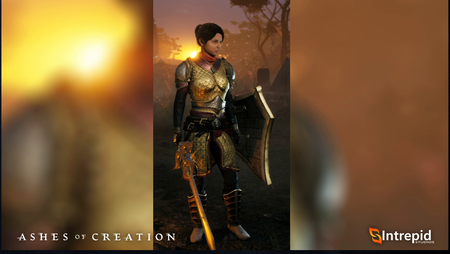
We want to be realistic with the application of particular types of armor, such as plate armor. In this regard for the different sexes there's a fine line that has to be drawn between accentuating the form of the sex as well as making it somewhat realistic and actually applicable to the environment.[59] – Steven Sharif
- Gear is intended to be realistic in appearance.[59][60][61]
- Armor will not be overly sexual in appearance.[59][61]
- I'm more of the mind that it wouldn't really serve a purpose to have bikini plate armor, just in like reality, if you're going to have armor, it should be protective. I think from a fashion statement is enjoyable for some people, but it's a an immersive issue.[60] – Steven Sharif
- Some armor and costumes will be more revealing than others, but there will not be nudity in the game.[63]
- There might be sliders, but there are not gonna be naked sliders.[63] – Steven Sharif
- Each race is getting its custom geo pieces, which then will share thematic components such as color palette, attachments, design filigree. Those types of things will get shared across the geo but generally you're going to see unique races with unique geo.[67] – Steven Sharif
- The appearance of crafted gear is influenced by its rarity.[68]
- Crafters are able to influence what their crafted items look like.[48][52]
- Cosmetics can be used by all races but there may be slight variations to make them work with the body builds of each race.[70]
- Dye cosmetics can be used to change gear colors.[71][72][73]
Artisan progression
Игроки должны выбрать путь в дереве навыков умельца для каждого персонажа.[78] В рамках каждого из трёх основных путей умельца (добыча ресурсов, обработка и ремесло) есть разные профессии. Персонаж может освоить только один из основных путей.[79][80][81][82]
- Можно освоить несколько профессий (но не все) в рамках основных путей умельца, но это будет долго и трудоёмко, потребует много ресурсов.[79][82][83]
Добыча ресурсов — это основной путь умельца, наряду с обработкой и ремеслом. Внутри каждого из трёх основных путей умельца лежат разные профессии. Вы можете освоить только один основной путь. Но вы можете потратить время на освоение каждой профессии в рамках основного пути умельца.[82] – Steven Sharif
Чтобы стать мастером какого-либо класса умельцев, мастером-переработчиком или мастером-добытчиком, потребуется значительное время и ресурсы.[86] – Steven Sharif
Прогресс класса умельца в дереве умельца происходит на основе опыта (повторения задач) в ветке, а также путём достижения определённых ориентиров в каждой ветке.[87]
- Игроки могут попробовать себя во всех профессиях на «начальном» уровне, прежде чем они решат освоить определенный путь.[88]
- Выбор определённого пути в дереве навыков даёт игроку возможность специализироваться в определённой области. Это поощряет взаимозависимость, игроков, улучшая игровой опыт умельца.[4]
- Мастерство — это умение создавать наилучшие предметы. Оно также даёт титулы, доступ к снаряжению, сделкам и заданиям. [89]
У игроков будет возможность попробовать себя во всех профессиях на самом начальном уровне, чтобы получить представление о том, что это за профессия и понять направление, в котором они хотят развиваться и перейти к овладению отдельными профессиями.[88] – Steven Sharif
Когда мы говорим, что невозможно стать мастером всех профессий, это означает, что нельзя освоить все три типа классов умельца (добыча ресурсов, переработка, ремесло). Вы сможете быть мастером только одного из них.[81] – Steven Sharif
Овладение мастерством
A character may only ever be a Master in up to 3 professions and Grandmaster in up to 2 professions across all artisan branches.[90][91]
- Artisan mastery is no longer restricted to a single branch.[91]
- Characters may change which professions they master.[92]
- Becoming a master Crafter or a master Processor or a master Gatherer should be a significant time investment and resource investment; and because of that it should also be something that when you achieve that status it's like people on the server know who you are.[86] – Steven Sharif
- Masteries aren’t just about making an item. They grant many things, including titles, access to items, bargains, and quests. [89]
- Previously it was stated that with considerable effort a player can master all professions within a mastered parent artisan class.[82][83] This was later changed to a player being able to master some but not all professions within a mastered parent artisan class.[79][78] This was changed to being able to master up to two or three professions within a mastered parent artisan class (subject to testing).[93] This was changed to being able to master up to two professions.[94] The current stance is only being able to become a Master of 3 professions and Grandmaster of 2 professions across all branches.[90][91]
- Q: What would be the daily activities for someone at level 50 with a maxed out artisan tree?
- A: The daily activity might be something along the lines of, depending on what type of profession or processor you are, of interacting with fellow artisanship individuals to wheel and deal on supply and demand chains; orchestrating and participating and caravan roads that move materials across the world so that you can satisfy buy orders and/or commission requests. Participating in unique trades and/or dungeon experiences that have the opportunity to acquire unique crafting materials so that you can create the dragon's legendary sword and sell that potentially. Finding unique harvestable materials in remote parts of the world or engaging in treasure map finding for again unique materials and/or processing things. There's a whole host of different intents that are loops for the players to participate in that again are situationally relevant based on the world state.[95] – Steven Sharif
Race or class locked crafting
Производство не будет привязано к расе или классу.[96]
Снаряжение умельцев
Ремесленная экипировка поможет крафтерам в собирательстве, обработке и ремесленных специализациях.[97][98]
- Ремесленная экипировка может быть использована в "дополнительных" слотах, которые могут быть переключены между боевой и ремесленной экипировкой.[97]
- Разработчики планируют сделать ремесленную экипировку доступной в Alpha-2.[97]
- Ремесленная экипировка будет неотъемлемой частью вашей боевой экипировки. На данный момент это лишь предположение - мы протестируем это, но сейчас мы находимся в стадии планирования. Ремесленная экипировка может быть выгодна для собирательства; она может быть выгодна для обработки, ремесла или для вашей специализации. Со временем вы получите эту экипировку, вы будете использовать ее, она будет находиться в дополнительных слотах. Вы также можете активировать ее и применять ее внешний вид, если вам хочется. Затем вы можете сменить ее обратно на свою боевую экипировку. На данный момент это и есть наш план. Мы проведем тесты. Существуют некоторые разногласия с командой о том, как именно воплотить это в реальность, но мы планируем запуск данной системы на Alpha-2. Я думаю, у нас будет хотя бы пара комплектов экипировки. Мы продемонстрируем все профессии ремесла - от собирательства до обработки и крафта в ограниченном варианте на Alpha-2. Мы хотим добавить эту возможность, чтобы протестировать ее. [97]
Цепочка поставок умельцев
Ремесленники в Ashes of Creation должны выбрать путь в своем дереве навыков ремесленника. Эта взаимозависимость устанавливает цепочку поставок от сырья до готовой продукции.[99][14] а каждом этапе цепочки могут потребоваться караваны для перевозки товаров от одного ремесленника к другому.[4]
- Получение сырья:[100]
- Использование профессии собирателя.[100]
- Убивая мобов и боссов.[101][100]
- От переработки оружия или доспехов.[100]
- Приобретая их у других игроков.[100]
- Переработка сырья с помощью профессии обработка.[14]
- Создание готового продукта с использованием его рецепта.[14]
Как ремесленник, вы захотите знать, где можно получить определенные рецепты; какие узлы имеют возможность создавать то, что вы обработали (материал) который вы собрали; а затем можете спланировать свой маршрут и перевозить товары в нужный вам район или убедиться, что вы находитесь в нужном районе, чтобы вы могли собирать/строить в этом районе.[102] – Steven Sharif
Добыча ресурсов
Первый из крупных моментов, которыми мы хотели бы поделиться, заключается в том, что в Ashes of Creation теперь стало возможно, благодаря расширению системы сбора, добывать множество ресурсов, которые вы увидите в открытом мире. Поэтому если вы наткнулись на какое-то дерево, вы можете его срубить. Если наткнулись на скалу — вы можете её раскопать.[103] – Steven Sharif
Добыча ресурсов — один из классов умельцев в Ashes of Creation.[106][107]
- Многие из видимых в открытом мире ресурсов (таких как деревья и руда) можно добывать.[103]
- Точный тип ресурса, присутствующий в месторождении, не будет известен до тех пор, пока не окажется собран.[105]
- В Ashes можно будет добывать много чего. Например, растения, деревья, руда, рыба, приручаемые животные и существа; мы хотим достичь определённой планки визуальной репрезентативности и сделать расположение ресурсов логичным, например, нет особой логики, если повсюду разбросаны золотые жилы в той же степени, что деревья и растения; мы хотели получить от игроков обратную связь относительно того, что они думают о некоторых добываемых типах ресурсов и о том, что о них нужно знать и чего от них ожидать. К примеру, руда — один из отличных примеров: вы видите какую-то условную скалу, но пока не разобьёте её, не узнаете, что в ней — порода, кристаллы, рубины или золото. Мы хотели испытать систему, при которой игрокам нужно было раскапывать их… то есть, будут, конечно, игрокам попадаться кучи, жилы или жеоды золота, но большая часть того, что они будут находить в открытом мире, если только они не искали что-то целенаправленно, потребует от них раскалывать эти камни.[105] – Kory Rice
- Для добычи нужно создать и использовать инструменты.[109][110]
- Разведка играет ключевую роль в помощи собирателям в идентификации ресурсов в конкретных областях мира.[111][112]
- Добыча ресурсов в пределах зоны влияния узла добавляет очки опыта этому узлу.[106]
- Часть низкоуровневых добываемых ресурсов всё равно будет присутствовать в качестве ингредиента в высокоуровневых рецептах ремёсел.[113]
- Некоторые низкоуровневые добываемые ресурсы будут полезны и в рецептах ремесленников более высокого уровня. Например, собираю я… синие лепестки, чтобы создать краситель для туники для персонажа первого уровня, но позже они же могут понадобиться мне для более мощных красителей, которые я буду использовать при создании высокоуровневого предмета. Так мы добавим ранговую прогрессию, чтобы у одних и тех же материалов сохранялась актуальность на разных уровнях ремесла; это важно с точки зрения стабильности экономики. Многоуровневый спрос с точки зрения поставщиков нужен для того, чтобы игроки, заинтересованные в сборе и добыче этих материалов, всегда оставались востребованными, даже когда начнут производиться более высокоуровневые предметы.[113] – Steven Sharif
Обработка
Обработка — один из классов умельцев в Ashes of Creation.[114]
- В процесс обработки входит очистка сырых материалов, полученных при помощи добычи, и разбор предметов.[114]
- Основная часть времени, затрачиваемого в системе умельцев, приходится на обрабатывающую ветку. Время обработки варьируется в зависимости от качества обрабатываемых предметов.[44]
- Часть процесса обработки может происходить в узлах, но самая лучшая обработка происходит на наделах.[43]
- Для строительства зданий наделов, требуемых для переработки ресурсов в обработанные товары, понадобятся чертежи.[115][116][44][109][114]
- Количество предметов, которые могут быть обработаны без вмешательства игрока, основывается на ранге конкретной обрабатывающей мастерской.[44]
- Время обработки можно снижать, увеличивая производительность и качество обработки обрабатывающей мастерской посредством ранговой системы развития.[44]
- Это будет очень важно на поздних этапах развития в игре в плане требуемых обработанных материалов. Потому что часть из них может потребовать несколько дней на обработку в мастерской, но если вы потратили время и потрудились, чтобы развить мастерскую обработки, время можно значительно снизить, может быть, даже больше, чем на 50%; это окажет значительное влияние на вашу способность контролировать рынки или производить товары.[44] – Steven Sharif
- Будет иметься подготовительный этап, на котором нужно будет загрузить требуемое топливо в здание для обработки материалов определённого уровня.[116]
- В плане обработки, в том виде, в котором она существует в Alpha-2, нужно будет сперва проводить определённую подготовительную работу в отношении специфичного для отрасли компонента, то есть здания. В эту подготовительную работу может входить нахождение определённого количества дров для разжигания горна или чего-то такого, для достижения определённой температуры для переработки руды конкретного качества; затем руда этого качества выплавляется в слиток аналогичного качества; и это, так сказать, и есть процесс создания слитка. Так вот, во всём этом процессе участвует элемент сбора, этап подготовки и элемент времени.[116] – Steven Sharif
- Также будут связанные со временем и геймплейные элементы, которые потребуют от игрока взаимодействовать с мастерской. Эти элементы регулируют скорость поставки обработанных материалов, полученных из сырых добытых ресурсов, на рынок.[116]
- Может быть, мы внедрим и геймплейные элементы для самого устройства, которое вы используете, например, если горн перегреется, вам придётся лить туда воду или что-то типа того. В этом процессе есть элементы, которые мы хотим использовать, чтобы дать игрокам возможность взаимодействия с игрой; причём не так, чтобы это была пустая трата времени. Но, конечно, временные затраты тоже являются частью этого процесса, потому что это регулятор скорости поставки обработанных сырых материалов на рынок.[116] – Steven Sharif
Upgrading items
Enchanting is not an artisan profession in its own right. Scribes create scrolls that can be utilized by different professions to create enchantments relating to that profession.[117][118]
- Enchantment scrolls can be sold on the open market.[34][117][119]
- Enchanting does not increase an item's level requirement.[120]
- You don't really push a particular item's level requirement or the identity of that item. You can enhance it, you can add enchantments to it, but it's still the item it is.[120] – Steven Sharif
Repairing items
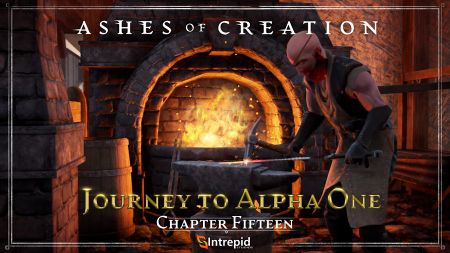
For example: if you have an iron sword and then the sword gets damaged from use, you have to use more iron to repair it; and what that does is... make sure that there's significant sinks in the game for base materials so that you are creating a scarcity and demand that's present on the creation of higher goods as well as supplying the necessary decay components for the world.[122] – Steven Sharif
Item repair will cost crafting materials.[123][122][124]
- 0% durability will unequip items, increasing its repair cost.[125]
- Damaged gear can be reforged at a player stall using a portion of the materials that were necessary to craft the item.[126][127][122]
- There may be additional constraints for repairing "very unique items", such as having a crafter and recipe to effectuate repairs. This is subject to testing.[128]
- There is no limit to the number of times an item can be repaired.[129]
There will be ways to repair destructible structures (such as walls and gates) and also repair (or re-craft) siege weapons that were damaged during sieges.[130]
- There's a lot of ancillary activities that can be had during sieges... It's obviously strategy and tactics and raid-versus-raid components, but also you want to have individual contributions where players can do things during the siege to aid in the greater effort so to speak; and it doesn't require you having 50 people by your side to effectuate that influence over something. So repairs are great ways to do that. Repairs for walls, repairs for gates, being able to spawn and essentially craft the designs for specific types of siege weapons to provide those to the team.[130] – Steven Sharif
Система депонирования
- An escrow system is planned to prevent griefing in the crafting system.[131]
- We're going to have a UI... you're gonna put the resources in or they're gonna put the resources in. It'll be like an escrow system and then once [the job] is complete you'll get the item they'll get the money.[131]
Сроки
Классы умельцев (собирательство, обработка, ремесло) полностью появятся в Alpha-2 и Beta-версиях.[132][133]
- Примерно 10 процентов системы ремесленников появилось в Alpha-1.[134][132][133]
- Крафтинг, честно говоря, не появится в конечном виде до Alpha-2. В Alpha-1 есть то, что должно стать основным геймплеем ремесла, то есть сбор материалов, преобразование этих материалов в обработанные товары и использование этих обработанных товаров для изготовления предметов. Это основной цикл игрового процесса, который в настоящее время присутствует в Alpha-1. Но в настоящее время они в основном поддерживаются за счет системы торговцев, а не за счет реальной системы ремесла; и это потому, что ремесло не было завершено в той форме, которая может быть реализована в Alpha-1, но будет реализована в Alpha-2. То, что есть в Alpha-1, даже не даёт представления о ремесле.[133] – Steven Sharif
Визуальные эффекты
2023-12-04 2023-09-05
Справочники сообщества
Смотрите также
Ссылки
- ↑ Прямая трансляция, 17 Августа 2018 (15:14).
- ↑
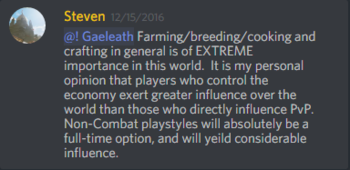
- ↑ Прямая трансляция, 24 Мая 2017 (17:08).
- ↑ 4.0 4.1 4.2 Прямая трансляция, 2017-05-10 (6:12).
- ↑ 5.0 5.1 5.2 5.3 5.4 5.5 5.6 Прямая трансляция, 2020-01-30 (1:38:26).
- ↑ 6.0 6.1 Прямая трансляция, 2017-05-12 (1:00:18).
- ↑ 7.0 7.1 7.2 Интервью, 2021-02-07 (45:41).
- ↑ 8.0 8.1 Подкаст, 2018-05-11 (27:20).
- ↑ Прямая трансляция, 2017-05-05 (20:41).
- ↑

- ↑ 11.0 11.1 11.2 11.3 11.4 11.5 11.6 11.7 11.8 Прямая трансляция, 2022-01-28 (1:19:48).
- ↑ 12.0 12.1 Интервью, 2021-02-07 (37:26).
- ↑ Прямая трансляция, 2017-05-26 (5:25).
- ↑ 14.0 14.1 14.2 14.3 14.4 14.5 Прямая трансляция, 2017-05-10 (8:22).
- ↑ Прямая трансляция, 2018-06-04 (35:11).
- ↑ Интервью, 2021-02-07 (38:15).
- ↑ 17.0 17.1 17.2 17.3 17.4 17.5 17.6 17.7 17.8 Прямая трансляция, 2018-04-8 (PM) (28:38).
- ↑ 18.0 18.1 18.2 18.3 Прямая трансляция, 2017-05-26 (26:00).
- ↑ Прямая трансляция, 5 Мая 2017 (34:15).
- ↑ Прямая трансляция, 5 Мая 2017 (8:22).
- ↑ 21.0 21.1 21.2 21.3

- ↑ Прямая трансляция, 2021-07-30 (1:16:05).
- ↑ Интервью, 20 Октября 2018 (17:31).
- ↑ Прямая трансляция, 2021-03-26 (1:07:33).
- ↑

- ↑ Подкаст, 2017-05-05 (43:05).
- ↑ Интервью, 2020-07-18 (27:11).
- ↑ 28.0 28.1 Видео, 2023-11-30 (59:21).
- ↑ 29.0 29.1 Видео, 2023-11-30 (1:01:04).
- ↑ Видео, 2023-08-31 (45:06).
- ↑ Blog: Exploring the Boundless Opportunities of Freeholds.
- ↑ 32.0 32.1

- ↑ 33.0 33.1 Прямая трансляция, 2023-04-07 (31:49).
- ↑ 34.0 34.1 Прямая трансляция, 2023-11-30 (1:38:47).
- ↑ Интервью, 2018-10-20 (17:31).
- ↑ Интервью, 2020-07-19 (6:38).
- ↑ 37.0 37.1 Прямая трансляция, 2023-12-19 (1:49:28).
- ↑ Development Update with Freehold Preview.
- ↑ Подкаст, 2021-09-29 (4:43).
- ↑ Прямая трансляция, 2023-12-19 (1:50:51).
- ↑ Прямая трансляция, 2022-07-29 (1:17:33).
- ↑ Прямая трансляция, 2023-11-30 (1:26:16).
- ↑ 43.0 43.1 Прямая трансляция, 2022-06-30 (1:08:02).
- ↑ 44.0 44.1 44.2 44.3 44.4 44.5 Подкаст, 2021-04-11 (40:20).
- ↑ Blog: Know Your Nodes - Scientific Node Type
- ↑ 46.0 46.1 Прямая трансляция, 2017-05-10 (14:45).
- ↑

- ↑ 48.0 48.1 48.2 48.3 48.4 48.5 48.6 48.7 48.8 Прямая трансляция, 2020-11-30 (1:05:22).
- ↑ 49.0 49.1 Подкаст, 2018-08-04 (59:58).
- ↑ 50.0 50.1

- ↑ 51.0 51.1 51.2 Прямая трансляция, 2020-12-22 (1:15:01).
- ↑ 52.0 52.1 Прямая трансляция, 2017-05-24 (24:19).
- ↑

- ↑

- ↑ About Ashes of Creation.
- ↑ February 8, 2019 - Questions and Answers.
- ↑ Подкаст, 2021-09-29 (52:58).
- ↑ Прямая трансляция, 2020-08-28 (1:14:54).
- ↑ 59.0 59.1 59.2 59.3 Прямая трансляция, 2020-05-29 (50:20).
- ↑ 60.0 60.1 Прямая трансляция, 2017-05-26 (19:51).
- ↑ 61.0 61.1 Reddit Q&A, 2019-01-8.
- ↑

- ↑ 63.0 63.1 Прямая трансляция, 2021-12-23 (1:34:07).
- ↑ Прямая трансляция, 2024-02-29 (1:15:51).
- ↑ Подкаст, 2018-08-04 (53:43).
- ↑ Прямая трансляция, 2022-10-28 (1:41:06).
- ↑ Прямая трансляция, 2021-09-24 (1:25:27).
- ↑ Прямая трансляция, 2023-11-30 (1:40:11).
- ↑

- ↑
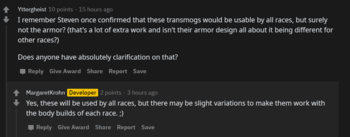
- ↑
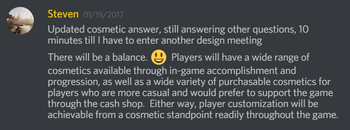
- ↑ Прямая трансляция, 2017-07-18 (54:56).
- ↑ Прямая трансляция, 2017-07-28 (9:47).
- ↑

- ↑ Прямая трансляция, 2020-10-30 (1:13:22).
- ↑
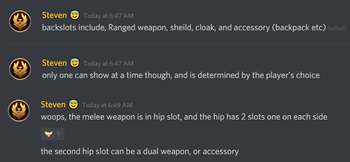
- ↑ Прямая трансляция, 2017-09-03 (48:56).
- ↑ 78.0 78.1

- ↑ 79.0 79.1 79.2

- ↑ Прямая трансляция, 2017-05-24 (32:07).
- ↑ 81.0 81.1 Прямая трансляция, 2019-07-26 (1:09:46).
- ↑ 82.0 82.1 82.2 82.3

- ↑ 83.0 83.1
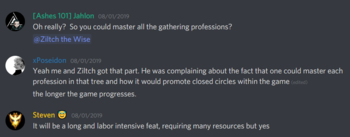
- ↑ 84.0 84.1
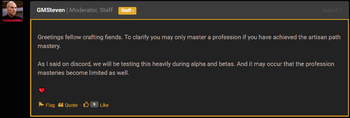
- ↑

- ↑ 86.0 86.1 Интервью, 2020-07-20 (18:47).
- ↑ Интервью, 2021-02-07 (36:38).
- ↑ 88.0 88.1 Интервью, 2020-03-27 (5:25).
- ↑ 89.0 89.1

- ↑ 90.0 90.1

- ↑ 91.0 91.1 91.2
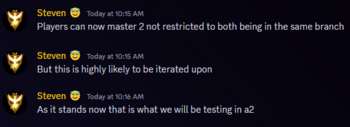
- ↑

- ↑ Прямая трансляция, 2022-04-29 (1:13:00).
- ↑

- ↑ Интервью, 2023-07-09 (42:51).
- ↑ Прямая трансляция, 28 Июль 2017 (22:36).
- ↑ 97.0 97.1 97.2 97.3 Прямая трансляция, 30 Июня 2022 (1:17:34).
- ↑ Прямая трансляция, 26 Марта 2021 (1:06:50).
- ↑ Интервью, 2020-07-20 (20:17).
- ↑ 100.0 100.1 100.2 100.3 100.4 Прямая трансляция, 2017-05-08 (20:41).
- ↑ Прямая трансляция, 2017-07-18 (38:30).
- ↑ Интервью, 2018-05-11 (24:18).
- ↑ 103.0 103.1 103.2 103.3 Видео, 2022-10-28 (0:47).
- ↑ Видео, 2022-10-28 (12:31).
- ↑ 105.0 105.1 105.2 Видео, 2022-10-28 (9:19).
- ↑ 106.0 106.1 106.2 Прямая трансляция, 2017-09-03 (10:48).
- ↑

- ↑ Прямая трансляция, 2021-07-30 (1:11:58).
- ↑ 109.0 109.1 Интервью, 2020-03-27 (9:00).
- ↑ Интервью, 2018-05-11 (38:25).
- ↑ Видео, 2022-10-28 (10:52).
- ↑ Прямая трансляция, 2022-04-29 (25:16).
- ↑ 113.0 113.1 Подкаст, 2018-05-11 (1:00:07).
- ↑ 114.0 114.1 114.2 114.3 Прямая трансляция, 2017-05-05 (34:15).
- ↑ Прямая трансляция, 2022-06-30 (1:09:29).
- ↑ 116.0 116.1 116.2 116.3 116.4 Прямая трансляция, 2022-02-25 (1:12:27).
- ↑ 117.0 117.1 Прямая трансляция, 2022-05-27 (1:20:00).
- ↑ Прямая трансляция, 2017-05-26 (51:37).
- ↑ Прямая трансляция, 2017-05-17 (58:55).
- ↑ 120.0 120.1 Прямая трансляция, 2021-03-26 (1:15:57).
- ↑
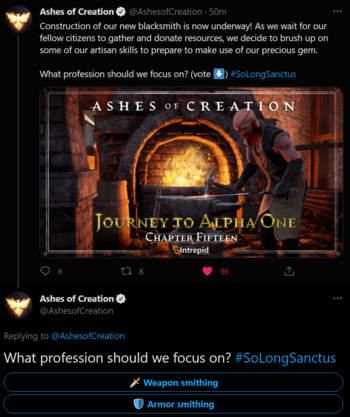
- ↑ 122.0 122.1 122.2 Интервью, 2020-07-19 (51:11).
- ↑ Интервью, 2021-02-07 (13:14).
- ↑ Podcast, 2017-05-13 (25:55).
- ↑

- ↑ Интервью, 2020-07-29 (16:46).
- ↑

- ↑ Прямая трансляция, 2021-05-28 (1:53:04).
- ↑ Прямая трансляция, 2020-09-30 (1:01:45).
- ↑ 130.0 130.1 130.2 Прямая трансляция, 2021-05-28 (1:04:29).
- ↑ 131.0 131.1 Прямая трансляция, 2017-05-10 (32:22).
- ↑ 132.0 132.1 Прямая трансляция, 2021-03-26 (42:28).
- ↑ 133.0 133.1 133.2 Интервью, 2021-02-07 (35:30).
- ↑ Прямая трансляция, 2021-04-30 (41:18).
